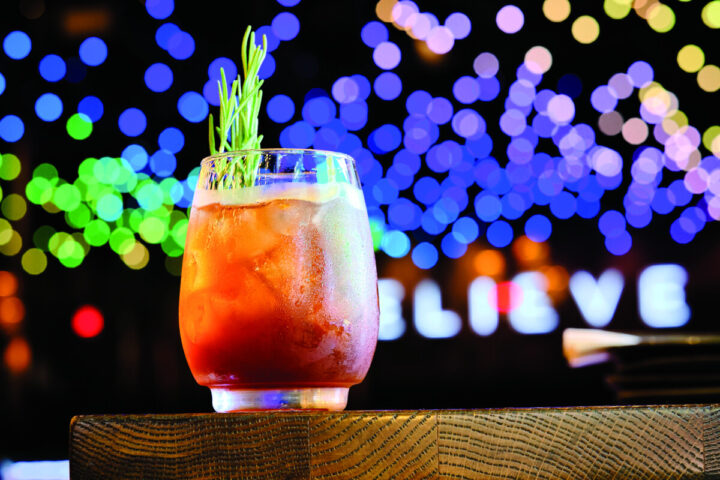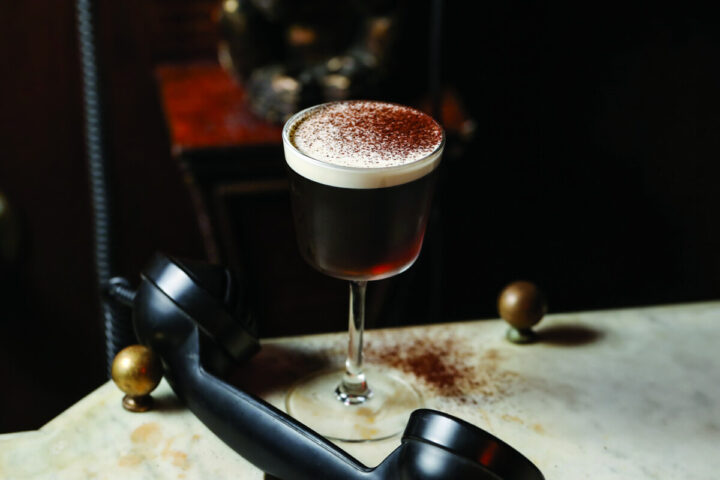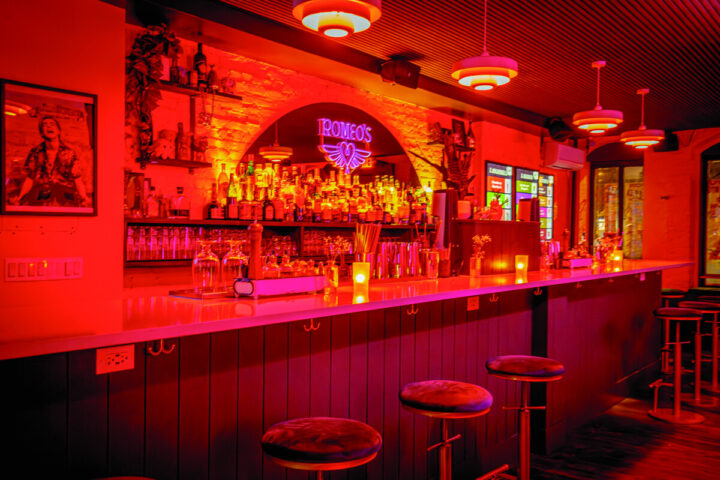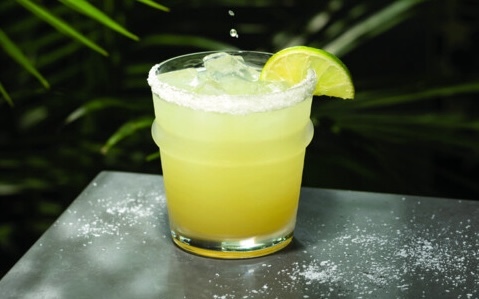
Serving pre-batched cocktails from a draft system is becoming more common in bars across the country— but don’t confuse the practice for a gimmick. “For us, it was a solution to operational challenges and opportunities,” says Ethan Albrecht-Carrié, vice president of growth and franchise development and director of beverage experiences for the Florida-based chain Lime Fresh Mexican Grill, which serves four of the chain’s signature Margaritas on draft in certain locations. “Ideally, all drinks should be made fresh, from scratch, and made to order—but that’s not always practical or possible. We chose to put some of our most popular items on draft to increase speed, consistency, and overall throughput, allowing our bartenders to focus on other cocktails that might need a little more TLC, as well as providing better service to our guests.”
Indeed, the most common reason a bar serves a cocktail, or several, on draft is for “speed, efficiency, and consistency,” according to Ryan Silva, bar lead at The Spare Room at the Hollywood Roosevelt hotel in Los Angeles. “Draft cocktails are beneficial for high-volume bars, as well as for cocktails that may be time-consuming when building them from scratch or just very popular,” he explains. “I’m sure plenty of bartenders have had a ticket with eight Espresso Martinis during a rush—if on draft, the time to create them is dramatically reduced to a couple minutes and can guarantee consistency in flavor and presentation.” The Spare Room serves one rotating cocktail on draft—a recent option was Hold My Calls ($18), a Grey Goose vodka-based take on the Espresso Martini. “For high-volume bars you have to consider creating a draft cocktail that’s not only creative but also tasty and something memorable,” Silva adds. “For the Hold My Calls we source our coffee beans from the Louisiana staple Café du Monde—the deep roasted flavor and earthy bitterness of the beans complement the smooth, clean taste and baked bread aromas that Grey Goose is known for. We then incorporate a few drops of saline solution and top off the cocktail with a house-made amaro foam, which rounds out the cocktail with a velvety and light texture.”
The Mothership in Milwaukee serves three draft cocktails: The Clover Club Spritz ($12), featuring Beefeater gin, Dolin Génépy le Chamois liqueur, house-made raspberry syrup, Sicilian limonata, and house-made rhubarb rose foam; the Oolong Island Iced Tea ($14), with a base of Tightline Organic vodka, Beefeater gin, Bacardi rum, and Cazadores Blanco Tequila, plus Joto Yuzu sake, clarified lemon juice, watermelon oolong tea, Olipop Vintage cola, and Angostura bitters; and the Fancy Paloma ($11), blending Cazadores Blanco Tequila, Combier Pamplemousse Rose pink grapefruit liqueur, Cocchi Rosa aperitif, clarified lime juice, Jarritos Grapefruit soda, and The Bitter Truth Grapefruit bitters. “Our draft cocktails are more popular than I ever thought they would be,” says owner Ricky Ramirez. “When guests walk into a busy bar with draft cocktails, they’re given the option of getting a cocktail incredibly fast. Some people want to see their cocktail physically built in front of them, and I understand wanting to see ‘the show,’ but having the ability to have a drink ready to go is appealing to others. I love having options for people at my bar.”
Silva also notes the popularity of these types of drinks. “In my past experiences, draft cocktails have always caught the attention of guests—it’s a great way to educate them on a different method of cocktail preparation,” he says. “You’ll get those few guests who are on the fence because they don’t see you technically building the cocktail in front of them, but once they taste one they’re usually believers. Of course, I enjoy how quickly I’m able to serve the guest, but I love seeing the surprise in their eyes after tasting a cocktail that took mere seconds to present to them a lot more.”

Benefits Abound
Mr. Melo in Brooklyn, New York serves four cocktails on draft, including the Bijou Blanco ($17), made with Rosaluna mezcal, Contratto Bianco vermouth, and Yellow Chartreuse liqueur, plus three force-carbonated options: the Staten Island Iced Tea ($17), mixing eight Italian amari and aperitifs, cola, and lemon juice; the John Dough ($17), an oat-milk clarified blend of Madre mezcal, Giffard Vanille de Madagascar vanilla liqueur, Café de Paris sparkling wine, passion fruit purée, and lemon juice; and the non-alcoholic Tamarind Maté Cooler ($11), comprising house-made chai-tamarind syrup and yerba mate, with the option to add Grey Goose vodka or Patrón Tequila for $6 more. “Draft cocktails are extremely consistent—there’s no room for human error when the same recipe is added to the kegs over and over, so every time the cocktail is served, it’s the same as the last time you had it,” says Nikolas Vagenas, Mr. Melo co-owner and bar director. “The ability to make more complicated drinks is also helpful—sometimes certain cocktails can take minutes to make and this expedites the process. For example, our John Dough cocktail takes an entire week to prep between times for clarification, filtering, and carbonation. By being able to prep that all ahead of time, we can serve a cocktail with way more complexity than your typical Gin and Tonic.”
At Romeo’s in New York City, the three cocktails served on draft may seem simple, but all have significant prep time behind them: The Toasted Coconut Mule ($18) features toasted coconut-infused Grey Goose vodka that’s been acid-adjusted with citric and malic acid, plus Fever-Tree ginger beer; the Mezcal Apple Cinnamon ($18) comprises Ilegal mezcal and house-made green apple cinnamon cordial, both of which are acid-adjusted, plus soda water; and the Cucumber Gin & Tonic ($18) blends Breckenridge gin and house-made cucumber and honeydew cordial, which are acid-adjusted, plus Fever-Tree Elderflower tonic water. “Draft cocktails are prep-heavy so that the serve can be done faster,” notes Romeo’s owner Evan Hawkins. “Once you dial in the prep your overall experience can be fast and consistent, which is truly every bar owner’s dream.”
Hailey Knight, beverage director at Félix Cocktails et Cuisine in Charleston, South Carolina, appreciates that draft cocktails can be more elaborate than made-to-order drinks. “It’s a great way for our team to showcase complex cocktails, ones that typically have a lot of ingredients, without the build time—we really like them for the speed and efficiency, especially on nights when we have a packed bar and guests waiting,” she says. Félix has two draft cocktails on its menu that change seasonally, with recent options including the La Viola ($15), mixing green tea-infused Cathead vodka, Chareau aloe liqueur, fresh lemon and lime juices, and Peychaud’s bitters; and La Pastèque ($15), featuring Cimarron Blanco Tequila, Chinola passion fruit liqueur, house-made watermelon shrub, and lemon juice.
In addition to increasing speed and consistency of service, draft cocktails also improve staff members’ experience, notes Lime Fresh’s Albrecht-Carrié. “My favorite part of introducing draft cocktails to the menu was communicating the win to our team—it meant their lives got easier,” he says. “They could serve more drinks, take care of their guests better and more efficiently, and ultimately, they would be making more money.”
For Father’s Office in Los Angeles, serving draft cocktails is in line with the bar’s brand identity, notes owner and lead bartender Caer Ferguson. “We’re one of the most well-known beer bars around; we were one of the first to put wine on tap—if we’re going to add cocktails to the lineup, I want them to be as efficient as pouring a beer, and for the cocktails to thoughtfully co-exist with the beer,” he says. The bar has three locations in the city, with two of them offering draft cocktails, including the Paloma Radler ($16), blending Pueblo Viejo Blanco Tequila, grapefruit juice, house-made lime cordial, and pilsner beer (brand varies), and the Affogato Martini ($18), comprising vanilla bean-infused Sibona grappa, Borghetti espresso liqueur, Averna amaro, and Italian roast cold brew. “These cocktails have been selling very well: The Paloma Radler is our highest selling cocktail and was recently our fourth highest selling beverage overall,” Ferguson adds. “Draft cocktails aren’t a catch-all answer to every style of cocktail being executed perfectly—some cocktails are better with different textures or with different temperatures. If you want a diverse and excellent cocktail program, you can’t have everything on draft. But in spaces like ours, where tap systems are already well-regulated and we also have a great prep program, it’s an incredible help.”

Tips And Tricks
Serving a quality-controlled draft cocktail requires lots of trial and error. “It’s crucial to test and validate your batch recipes—some ingredients might not scale 100% and may need to be adjusted,” notes Albrecht-Carrié, adding that pre-diluting each drink is a vital step. “The level of dilution depends on the cocktail and the recipe—most of ours require about 20% pre-dilution, so we add water into the recipe before it goes into the keg,” he says. “To serve, we prep the glass, pour in the drink, and then top with ice and garnish. Filling the glass with ice ahead of time can vary the amount of liquid in each glass and lead to watered-down drinks if cocktails sit on ice waiting to be served. This is more impactful for drinks made to order but is still a good habit for kegged cocktails.”
While there are clear benefits to pre-batching and kegging cocktails to serve on draft, the practice does come with challenges, so being diligent and thorough is key. “The most important component in executing a draft cocktail is maintaining your draft lines and ensuring the pressure coming out of the keg is always stable and consistent,” notes The Spare Room’s Silva. “Another good guideline to keep in mind is to agitate your kegs before and during service to ensure all the ingredients are always mixed well.”
At Your 3rd Spot in Atlanta, the bar team can skip the step of agitating their cocktail kegs thanks to the system they use. “We use high-quality vortex kegs that magnetically keep a piece spinning inside the keg at all times to ensure nothing settles to the bottom or separates, so there’s a homogeneous, properly mixed cocktail pouring at all times,” says Doug Warner, co-founder and chief solutions officer. The bar offers eight different draft cocktails ($11-$13), including takes on the Margarita, Lemon Drop, Mai Tai, Sangria, Espresso Martini, Old Fashioned, and more. “I would say the biggest challenge is being prepped and meeting pars,” Warner adds. “You have to study your product mix and understand expected demand to properly order and prep—because the batches use such a high volume of product, you can easily run out if not prepared. Batches are so large as well, so any mistakes in recipes are difficult and expensive to fix. If a keg gets tipped over and spills, that’s hundreds or even over a thousand dollars in product pouring down the drain.”

Knowing The Limit
Not every cocktail type is the right fit for serving on draft. “When thinking about specific recipes and styles for draft, go for cocktails that hold up over time, and avoid any non-stable ingredients, like dairy, egg whites, or fresh herbs,” says Félix Cocktails et Cuisine’s Knight. “Recipes that rely on shelf-stable bitters and liqueurs, like a Manhattan or Negroni, tend to work best. Carbonated cocktails, like a French 75, also work well but it’s important to note that if the carbonation isn’t just right, you’ll either get a foamy mess or a flat drink, neither of which we want. Ingredients with different densities, like syrups and juices, can settle in the keg, so it can take some trial and error to get it right.”
Mr. Melo’s Vagenas also notes the importance of managing the gas—either carbon dioxide or a blend of nitrogen and carbon dioxide—levels on draft cocktails. “You want to keep your pressure for pushing the gas out low, as high PSI can lead to lots of foam when pouring your cocktails—I keep ours at around 10-15 PSI,” he advises. “Also keep your contents pulp-free, meaning that there’s as little texture to your drinks as possible, otherwise you’ll clog your lines.” The Mothership’s Ramirez echoes this last point: “Getting as much pulp out of citrus and juices is critical—if citrus is going in, it should be clarified to have fewer impurities for the carbon dioxide to work against,” he says. “Regarding styles, I would say for still drinks, Daisies and Old Fashioned cocktails are a good bet. Negronis are popular, but I would advise quality control measures for the vermouth. With carbonated drinks, long drinks with some flair are a good bet. Our Paloma is wildly popular, and so is our Oolong Island Iced Tea. The possibilities are endless with carbonated drinks.”
Ramirez adds that the labor involved with draft cocktails can be a challenge. “I have to spend time and energy on our draft cocktails since we clarify our drinks, including breaking down the citruses with enzymes before running them through a centrifuge,” he explains. “The part where we’re batching is easy, but there’s a lot of technique involved in ensuring everything we batch before we keg and carbonate is on point so as not to ruin a batch.” Hawkins of Romeo’s also notes the substantial undertaking of the prep that goes into draft cocktails. “We have four draft cocktails and at our volume we need a full-time prep team to make sure that we can keep up with it, so managing the production can be difficult if you’re not on top of it,” he says.
Despite the associated challenges, draft cocktails will remain a useful solution in the right location. “It’s not a replacement for good training and the care and passion for the craft, but another tool to be used in the kit, so to speak,” Lime Fresh’s Albrecht-Carrié says. “Just as we see wine on draft and sous vide being used in the kitchen, it can be a great option and solution in many situations, but it’s not a solve-all. There will always be a need for the shake and stir and the showmanship that goes into building a beautiful cocktail—draft cocktails will never replace that. But they may help bartenders and mixologists execute their craft and provide better hospitality to their guests and that’s a win as far as I’m concerned.”